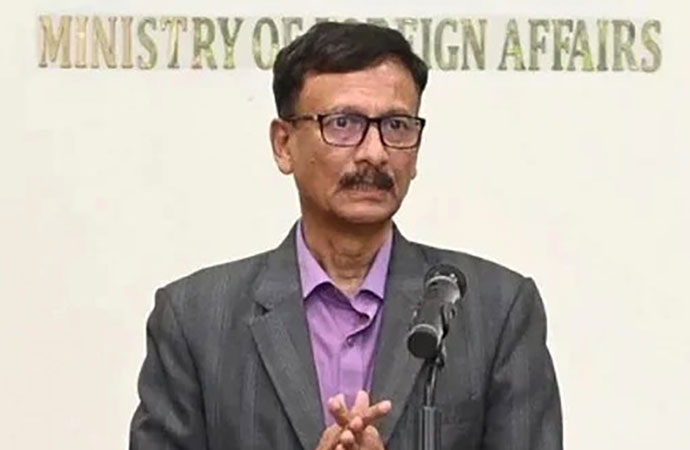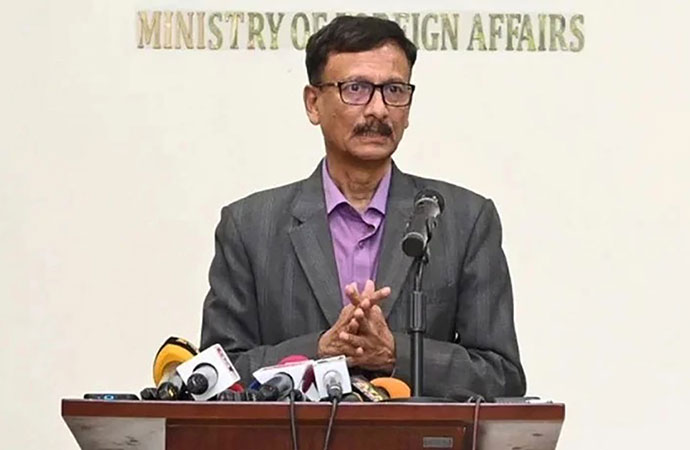Reportage

A woman with children rows a raft made from banana trees toward a safer area from the flooded village of Tarabari, in the northeastern Indian state of Assam, Monday, June 20, 2022. Early and strong monsoon rains have brought heavy flooding to northeastern India and Bangladesh, killing dozens of people, forcing hundreds of thousands from their homes and cutting off millions from crucial supplies. Photo: AP/UNB
A third wave of flash floods in a matter of weeks devastated the north-eastern part of Bangladesh this week, especially Sylhet, Sunamganj, Netrokona and Habiganj districts. Heavy rainfall starting from June 10 in north-eastern India largely contributed to the increased water level of the rivers in Sylhet division. One that turned into record levels of precipitation even for Cherrapunji and Mawsynram, two Meghalayan towns close to the Bangladesh border that are famous for being the wettest in the world, Sylhet and its adjoining areas were bound to take a hit. But did it have to be so catastrophic?
The situation was particularly dire in the two frontier districts of Sylhet and Sunamganj, where residents have described the 'worst flooding in living memory'. Even experts were at a loss to foresee the sheer pace at which the two districts have been inundated since Thursday, June 16, - in close concert with the record rainfall witnessed in Mawsynram and Cherrapunji.
The day after, the Sohra region of Cherrapunji recorded its third highest rainfall ever in a 24-hour period, an incredible 972.0 mm. It added up to some 2500 mm over three days starting June 15 - the highest amount over a 3-day period in 27 years.
Mawsynram recorded 1003.6 mm on Friday, its highest ever for a day in June. With the waters inevitably destined to make their way down fiercely over the hilly terrain and rivers running downstream into Bangladesh, a bout of flash flood in Sunamganj and Sylhet was inevitable, and that is exactly what happened. But the lack of preparation on the part of the administration was quite glaring, for something that had been widely forecast.
At its peak, around Saturday (June 18), the unprecedented flooding inundated an astonishing 80 percent of the territory under Sylhet district, and 90 percent of Sunamganj, according to the official Flood Forecast and Warning Centre. The power grid in both districts started going down on Friday, and by Saturday afternoon was gone completely. Although it was restored relatively soon in Sylhet city - which is a fairly small part of the area affected - large parts of both districts were left without it for days.
Almost all communication with Sylhet and Sunamganj has been lost, Airport and train communication were halted for indefinitely. All type of services (fire station, food storages, hospitals etc) became inaccessible as water inundated the critical infrastructures, leaving the affected population even more helpless.
Experts considered the flood in Sylhet worse than the ones experienced in 1998 and 2004. The crisis struck at a time when the people of the division were recovering from another flash flood that hit in late May, and there was one earlier in May as well. An estimated 7.2 million people have been affected by this sudden flash flood and water congestion in nine northeastern districts of Sylhet. Besides Sylhet and Sunamganj, Moulvibazar, Habiganj and Netrakona were the most heavily hit. Almost half a million took refuge in some 1,605 shelter centres in a combined effort of the Army, Navy, Fire Service, and the local authorities, according to the Ministry of Disaster Management and Relief (MoDMR).
According to a June 22nd report prepared by the Unicef country office, 3.5 million of the 7.2 million affected population are children.
"Regular water sources are at high risk of contamination with microorganisms, sewage, heating oil, agricultural or industrial waste, chemicals and other substances," states the report shared with other UN agencies. "Sanitation facilities are poor and unhygienic, all can cause serious illness and (are) putting strain on the already affected health facilities."
According to the Department of Public Health Engineering (DPHE), 44,254 water points and 49,885 sanitation facilities have been damaged and 90 percent of health facilities have been inundated in Sylhet division, while cases of waterborne disease rose from 1,700 to 2,173 as of June 21. The Unicef assessment adds that the evacuation centres are not adequately equipped with the required provisions to ensure the safety and security of women, girls, and children. More than 3,300 Government Primary schools are affected and about 2,400 non-formal learning centres are submerged in seven districts.
The role of climate change
Scientists told the Associated Press that climate change is a factor behind the erratic and early rains that triggered unprecedented floods in Bangladesh and northeastern India, killing dozens and making lives miserable for millions of others.
Although the region is no stranger to flooding, it typically takes place later in the year when monsoon rains are well underway.
This year's torrential rainfall lashed the area as early as March. It may take much longer to determine the extent to which climate change played a role in the floods, but scientists say that it has made the monsoon - a seasonable change in weather usually associated with strong rains - more variable over the past decades. This means that much of the rain expected to fall in a year is arriving in a space of weeks.
The northeastern Indian state of Meghalaya received nearly three times its average June rainfall in just the first three weeks of the month, and neighbouring Assam received twice its monthly average in the same period. Several rivers, including one of Asia's largest, flow downstream from the two states into the Bay of Bengal in low-lying Bangladesh, a densely populated delta nation.
With more rainfall predicted over the next five days, Bangladesh's Flood Forecast and Warning Centre warned Tuesday (Jun. 21) that water levels would remain dangerously high in the country's northern regions.
The pattern of monsoons, vital for the agrarian economies of India and Bangladesh, has been shifting since the 1950s, with longer dry spells interspersed with heavy rain, said Roxy Matthew Koll, a climate scientist at the Indian Institute of Tropical Meteorology in Pune, adding that extreme rainfall events were also projected to increase.
Until now, floods in northeastern Bangladesh were rare while Assam state, famed for its tea cultivation, usually coped with floods later in the year during the usual monsoon season. The sheer volume of early rain this year that lashed the region in just a few weeks makes the current floods an "unprecedented" situation, said Anjal Prakash, a research director at India's Bharti Institute of Public Policy, who has contributed to U.N.-sponsored study on global warming.
"This is something that we have never heard of and never seen," he said.
Prime Minister Sheikh Hasina gave a similarly grim assessment Wednesday.
"We haven't faced a crisis like this for a long time. Infrastructure must be constructed to cope with such disasters," she told a news conference in Dhaka. "The water coming from Meghalaya and Assam has affected the Sylhet region," she said, adding that there is no quick respite for the country.
Hasina said that floodwaters would recede soon from the northeast, but they would likely hit the country's southern region soon on the way to the Bay of Bengal.
"We should prepare to face it," she said. "We live in a region where flooding happens quite often, which we have to bear in mind. We must prepare for that."
A total of 42 people have died in Bangladesh as of June 22 in this year's flood, while Indian authorities reported that flood deaths have risen to 78 in Assam state, with 17 others killed in landslides. Hundreds of thousands are displaced and millions in the region have been forced to scramble to makeshift evacuation centres.
Bangladesh, home to about 160 million, has historically contributed a fraction of the world's emissions. Meanwhile, a decade-old deal for rich nations, who have contributed more to global emissions, to give $100 billion to poorer nations every year to adapt to climate change and switch to cleaner fuels hasn't been fulfilled. And the money that is provided is spread too thin.
That means that countries like Bangladesh - whose GDP has risen from $6.2 billion in 1972 to $305 billion in 2019 - have to redirect funds to combat climate change, instead of of spending it on policies aimed at lifting millions from poverty.
"This is a problem which is created by the global industrialised north. And we are paying the price for it because they have ignored their responsibility," Prakash said.
In the hardest-hit city of Sylhet, shop owner Mohammad Rashiq Ahamed has returned home with his families to see what can be salvaged from floods. Wading through knee-deep water, he said that he was worried about waters rising again. "The weather is changing ... there can be another disaster, at any time."
He is one of about 3.5 million Bangladeshis who face the same predicament each year when rivers flood, according to a 2015 analysis by the World Bank Institute. Bangladesh is considered one of the most vulnerable to climate change and the poor are disproportionately impacted.
Parul Akhter, a poultry farmer, held on to her disabled son to save him from the floodwaters in Sylhet. But she lost her only income - her chickens - and all other belongings.
"The chicken farm was the only way for me to live. I have no other means to earn," she said.
Mohammad Arfanuzzaman, a climate change expert at the U.N. Food and Agriculture Organization, said that catastrophic floods like the one this year could have wide-ranging impacts, from farmers losing their crops and being trapped in a cycle of debt to children not being able to go to school and at increased risk to disease.
"Poor people are suffering a lot from the ongoing flooding," he said.
Beyond help
Authorities in both India and Bangladesh struggled to deliver food and drinking water to hundreds of thousands of people evacuated from their homes. In Sylhet, villagers waded through streets flooded up to their knees. One man stood in the doorway of his flooded shop, where the top shelves were crammed with items in an effort to keep them above water. Local TV said millions remained without electricity.
Enamur Rahman, junior minister for disaster and relief, said up to 100,000 people have been evacuated in the worst-hit districts, including Sylhet. About 4 million were marooned, our sister newsagency UNB reported. In a country with a history of climate change-induced disasters, many expressed frustration that authorities haven't done more locally.
"There isn't much to say about the situation. You can see the water with your own eyes. The water level inside the room has dropped a bit. It used to be up to my waist," said Muhit Ahmed, owner of a grocery shop in Sylhet.
"We are in a great disaster. Neither the Sylhet City Corporation nor anyone else came here to inquire about us," he said. "I am trying to save my belongings as much as I can. We don't have the ability to do any more now."
Reports were rife across the media, to go with countless accounts on social media, of villagers in remote areas struggling to obtain drinking water and food. But the government stubbornly refused to accept any suggestion that it was slow off the mark, or took its eye off the ball. The fact that this was in turn being tied to all their (and the media's, to be fair) energy being spent on the grand inauguration and celebrations planned for the Padma Bridge put them even more on the defensive.
On her shoulders
The prime minister has been particularly keen to stress that her government took immediate measures to cope with the flood situation.
She made it the focus of her remarks, for example, when Ambassador and Head of Delegation of the European Union to Bangladesh Charles Whiteley called on her at her Sangsad Bhaban office, She was in fact freshly returned from flying by chopper to Sylhet herself to survey the situation, and more importantly the administration's response, first hand, earlier that day. She explained the current flood situation in the North-Eastern part of Bangladesh to the envoy, what she had observed and ascertained at a discussion meeting with the volunteers, party activists, and government agencies who are actively working to rescue the affected people.
The PM's bipartisan approach to relieving the people of their suffering came through in the way she engaged with the BNP's Ariful Haque Chowdhury, the mayor of Sylhet.
The EU ambassador expressed his satisfaction over Bangladesh's preparedness and resilience to combat this kind of seasonal natural disaster caused mainly by the monsoon rain.
Sheikh Hasina said that the government built cyclone shelters in the south and multipurpose flood shelters in the northern part of Bangladesh as disaster preparedness. Furthermore, she stated that Bangladesh, as a riverine country, faces tremendous challenges of river erosion and the impact of climate change.
To that end, she briefly narrated her visions, including Bangladesh Delta Plan-2100. While discussing Padma Bridge, Prime Minister Sheikh Hasina said that its inauguration will open up a new horizon for the southern districts of Bangladesh.

























Leave a Comment
Recent Posts
Remembering Kalidas Karmakar ( ...
The art world remembers Kalidas Karmakar, a visionary whose creativity ...
An Evening with Shishir Bhatta ...
Cosmos Art Echo, the artist talk initiative of Gallery Cosmos and Cosm ...
Myanmar denies genocide, calls Rohingya crackdown co ..
Yes, of course
Earth’s average temperature last year hovered among ..
Bangladesh and Singapore: A Tale of Two Nations